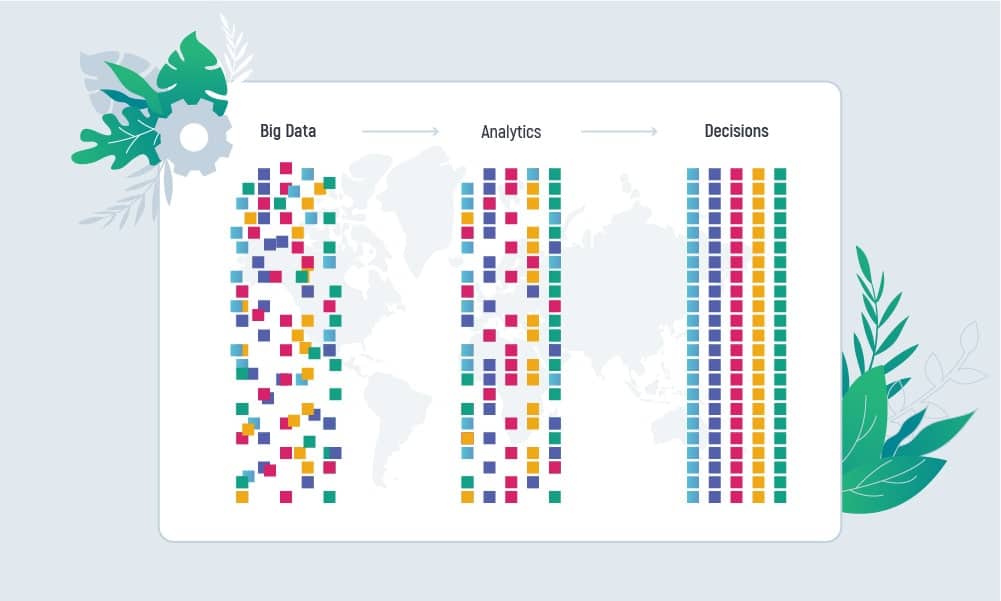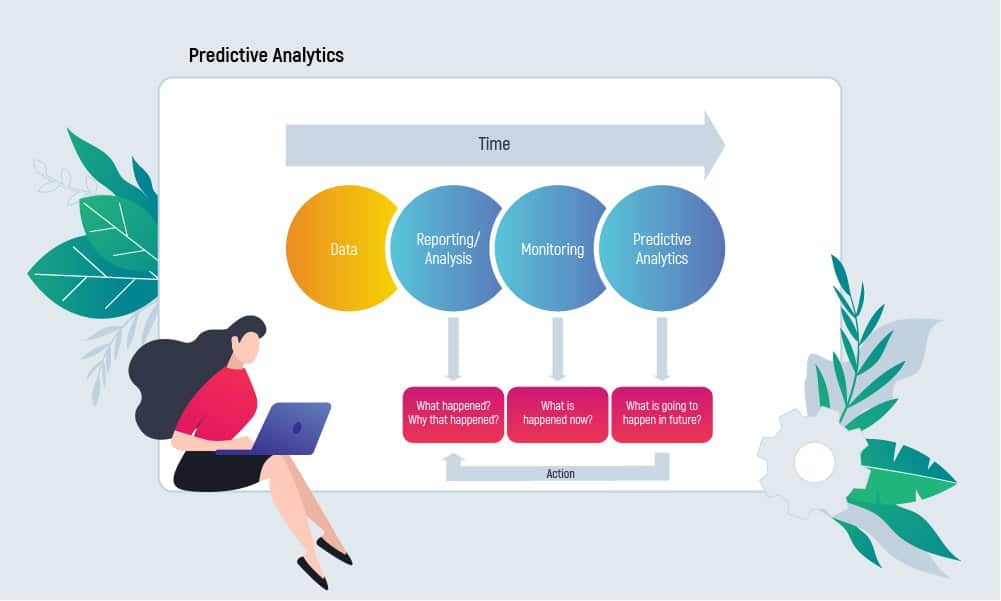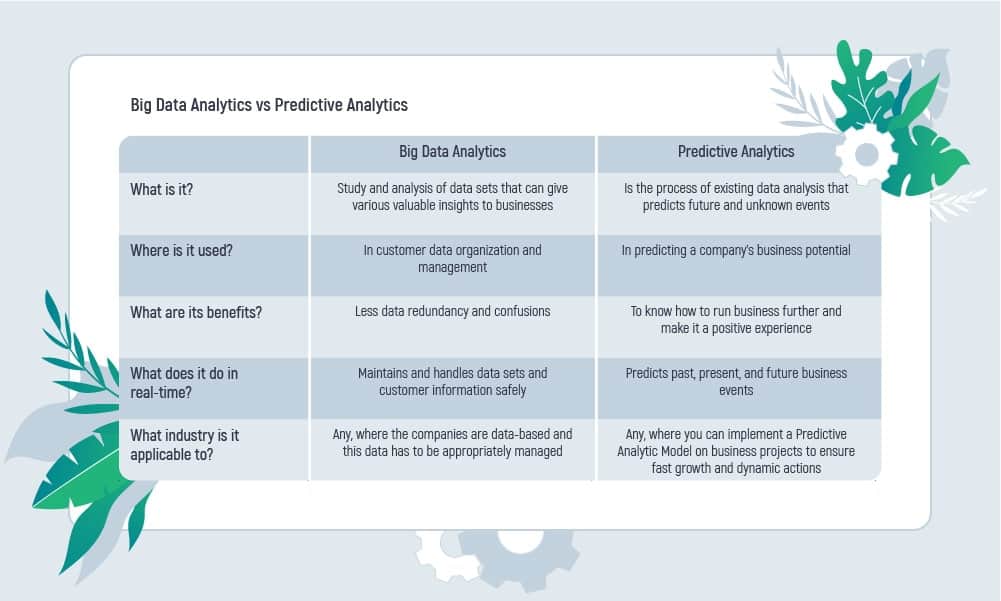Big Data Analytics can help with obtaining potential user data, processing it, cleansing it, and receiving a valuable output, while predictive analytics utilizes historical data to forecast future outcomes, empowering businesses to anticipate market dynamics and optimize strategies.
Aiming to elevate your business or develop a product? Big Data Analytics and Predictive Analytics are pivotal. This article explains how big data and predictive analytics work, explores their impact, benefits, workings, and application across industries. Let's dive into the transformative potential of these cutting-edge technologies and uncover how they can revolutionize your business strategy.
- Impact of Big Data on Predictive Analytics
- What are the Benefits of Big Data Analytics?
- How does Big Data Analytics Work?
- Collecting data
- Processing data
- Cleansing out
- Analyzing
- What is Predictive Analytics in Big Data?
- What are the types of Predictive Analytics?
- Predictive modeling
- Descriptive modeling
- Decision-making modeling
- What are the benefits of Predictive analytics?
- How do Predictive Analytics work?
- Big Data Analytics and Predictive Analytics Comparison
- How is the world using big data for predictive analysis?
- Decision trees
- Regression
- Neural Networks
- Industries and projects that utilize predictive analytics
- Inoxoft’s Experience
- Conclusion
Impact of Big Data on Predictive Analytics
Big Data stands for raw and voluminous sets of information that become valuable in studies and analyses. The more new technologies we have the more capacity of data these technologies accumulate. So, it is of great importance to make use of these large amounts of information by analyzing them. And, this type of analysis requires specific tools and automation as humans cannot process big data manually, because it’s impossible. The process of automated big data analysis is called big data analytics.
Big Data Analytics is a vast complex of processes that analyze Big Data from different perspectives to make sure there are patterns and correlations, market trends, and customer preferences with the help of which organization can make the right business decisions. So, data analytics is one of the biggest priorities of all organizations in any industry there is. To learn more about how big data analytics impacts industries get to read our topic-related articles:
Big Data is a complex of technologies that collect huge sets of information that are multiplying continuously. Predictive analytics is the process of analyzing raw data, processing it into structured data, and identifying patterns to predict future events.
What are the Benefits of Big Data Analytics?
Allied Market Research reports that the big data and business analytics market worldwide is forecasted to reach $420.98 billion by 2027. And it’s no wonder, as organizations can benefit from using big data analytics software and tools and make data-driven decisions to improve business outcomes. The most common improvements might include efficient marketing, new revenue, customer personalization, and improved effectiveness of operations that could lead a business to the top among its competitors.
Among the potential benefits of Big Data Analytics you can find:
- A quick analysis of large amounts of data that exist in different sources, formats, and types
- Ability to make fast and better decisions to strategize more effectively, improving areas of strategic decision-making such as supply chain, and operations
- Possibility to save costs savings, with the help of effectively optimized business processes
- Deeper knowledge of customer needs, behavior and emotions, that positively impact marketing insights and give extensive information for further product development
- More efficiently conducted strategies of risk management that are extracted from large samples of data
Analytics Insight reports 10 Big data analytics technologies to look up this year. These are:
- Apache Hadoop, a software library that uses simple programming models to carry out distributed processing of large data sets across clusters of computers.
- MongoDB, a distributed document-based database with the main purpose to assist modern application developers in the development and work with the cloud.
- R, a free-of-charge software environment created for statistical computing and graphics.
- Tableau, a visual analytics platform that helps to see and understand data that can solve potential problems.
- Cassandra, an open-source NoSQL database manages large amounts of data with a significant speed, and with the highest performance possible.
- Qlik, an end-to-end, multi-cloud data integration analytics solution that turns raw data into valuable insights that might close all the informational gaps.
- Splunk, a data analytics platform with extra security, observability, IT operations, and everything that includes data processing.
- ElasticSearch, a distributed, analytics engine with RESTful search that can address the increasing quantity of use cases.
- Knime, a software that creates and produces data science with an easy and intuitive environment, enabling big data stakeholders to focus on their core input.
- RapidMiner, an end-to-end transparent data science platform that is integrated and optimized for building ML models, designs these models using a visual workflow designer or automated modeling and deploys ML models turning them into beneficial actions.
Read more: Data Analytics for manufacturing
How does Big Data Analytics Work?
Mainly, Big Data Analytics makes use of 4 key processes as Bitnews Today states. These are collecting data, processing information, clearing out, and analyzing. Let’s look a bit closer at each of these processes.
Predictive analytics solutions refer to extracting information from existing data sources. By using techniques like artificial intelligence, statistical modeling, and machine learning, it aims to determine patterns and predict future results.
Collecting data
Mobile records, customer feedback forms, mail threads received from customers, survey reports, social media platforms, and mobile applications are the sources data analysts can collect specific information. Different businesses try to make use of data collecting and extract all the valuable information there is to gain insight, advance, and prosper. Big Data analyzed from the older enlisted is quite chaotic – unstructured or semi-structured. Thus, this information is not readable without using specific tools.
Processing data
After the data is collected, the next step to make use of it will require data storage in the data pool or warehouse. Being located in one convenient place allows analysts to organize, configure, and group parts and bits of big data to draw a larger picture per request that will be also more accurate about final results.
Cleansing out
To make sure the processed data analysts work with is complete and feasible, it has to be clean from duplications, watery inputs, system errors, and other sorts of deviations. So, this step allows to polish big data to receive more accurate results afterward.
Analyzing
This is the final step, where the raw data that was collected, processed, and cleansed can be analyzed with the possibility of extracting the much-needed results. Here, you can use:
- Data Mining (helps extract useful and feasible data patterns)
- Artificial intelligence (using human-like thinking to explore and extract deep data analytics)
- Text mining (with the help of AI it is possible to get meaningful informational insights out of a pool of unstructured textual information)
- Machine Learning (using AI to make computers learn based on their past experiences)
- Predictive Analytics (great predictions and future insights for a business based on past and historical data analyses)
- Deep learning (analysis and extraction of huge and unmanaged data)
Although Big Data Analytics has numerous possibilities and methodologies to analyze data, let’s focus on predictive analytics and its manifestation in 2021.
What is Predictive Analytics in Big Data?
According to IBM, big data predictive analytics belongs to advanced analytics. It can predict future results with the help of historical data, statistical modeling, data mining, and machine learning. Businesses use predictive analytics to understand their risks and opportunities with the help of the data patterns it is possible to predict.
Predictive analytics also belongs to big data and data science. Today, businesses use transactional database data, equipment log files, images, video, sensors, and other data sources to gain insights. You can extract information from this data with the help of deep learning and machine learning algorithms. What can you get out of extracting data? You will see patterns in the scope of data and will be able to forecast future events. For example, the algorithm approach includes linear and nonlinear regressions, neural networks, support vector machines, and decision trees.
What are the types of Predictive Analytics?
Generally, there are three types of predictive analytics businesses can apply to:
- predictive modeling
- descriptive modeling
- decision-making modeling
Predictive modeling
Predictive modeling needs statistical data to be able to predict the outcomes. The main goal of predictive modeling is to make sure that similar units in different samples have similar performance or vice versa. For example, you can predict your customer’s behavior and credit risk with the help of predictive modeling.
Descriptive modeling
Descriptive modeling tends to classify customers to describe certain relationships within a dataset. So, as a result, you get a summary of different relationships between customers and products, e.g. product preferences accounting for age, status, gender, etc.
Decision-making modeling
Decision-making modeling shows a clear relationship between elements in a decision. These may be the data, the decision, and the forecasted results. The relationship between elements can potentially predict future results, increase the probability of the needed outcomes and decrease the others.
What are the benefits of Predictive analytics?
According to the G2 catalog, there are the main 8 benefits any business can obtain with the help of predictive analytics. So, applying to predictive analytics can:
- Make you more competitive in the market
- Open up new product (service) opportunities
- Optimize the performance of the product (service)
- Gain insights according to customers’ preferences
- Decrease cost waste and risk occurrence
- Address problems immediately
- Meet user demand 100%
- Improve collaboration
The other potential benefits of predictive analytics are in the detection of:
- possible fraud to be warned against it
- pattern consistency so they could be improved
- Illegal actions that can be prevented
- marketing campaign flaws that can be optimized
- сustomer purchase preferences to know about
- planning workforce pluses that can be enhances
- churn rate that can be analyzed
- сompetitor progress that can be analyzed
How do Predictive Analytics work?
To make use of predictive analytics, every business should be driven by a business goal. For instance, the goal might be cost reduction, time optimization, and waste elimination. The goal can be supported with the help of one of the predictive analytics models to process an abundance of data and receive results that were desired initially.
Based on the explanation above, let’s define some basic steps for applying predictive analytics. For instance, to predict the sales revenue it is obligatory to:
Step 1. Take data from multiple sources, especially the ones with product sales data, marketing budgets, and the national gross domestic product (GDP) value.
Step 2. Cleanse the data from any unnecessary constituents and accumulate it or group it according to similar data types.
Step 3. Create a predictive model. E.g. neural networks can be applied to revenue forecasting.
Step 4. Develop the model into the environment of production and make it accessible through other apps.
Discover more: healthcare CRM software benefits
Big Data Analytics and Predictive Analytics Comparison
Big data and predictive analytics sound similar in some cases, but they are not. So, let’s look closer at predictive analytics and big data comparison to understand what’s different.
How is the world using big data for predictive analysis?
To predict future events, predictive analytics identifies patterns of Big Data that are meaningful. Predictive analytics can be applied to unknown data in the present, past, and future. Predictive analytics using big data is capable of providing valuable business intelligence.
To make an impact, predictive analytics in big data has several working models. These are:
Decision trees
This model looks like a tree, where the branches of the tree indicate available choices, and individual leaves denote a decision. This model is simple to use and can save you time in urgent decision-making, predicting the best outcome in a short time.
Regression
This model is used in statistical analysis, where you have large sets of data and need to determine certain patterns. Also, there should be a linear relationship between the inputs. The model makes up a formula, which shows the concrete relationship between all the inputs found in the dataset.
Neural Networks
This model imitates human brain work in a way. It deals with complex data relationships applying to AI and pattern recognition. Having a problem with voluminous data that requires understanding the relationships between inputs and outputs or a need to predict events makes this model a helpful tool to use.
Industries and projects that utilize predictive analytics
Industries that have voluminous data to analyze are actively using big data for predictive analysis. These industries are:
- Health Care
- Retail
- Banking
- Manufacturing
- Public Transportation
- Cybersecurity
Projects that are the most suitable for using big data and predictive analysis are:
- Big Data for cybersecurity
- Health status prediction
- Anomaly detection in cloud servers
- Recruitment for Big Data job profiles
- Malicious user detection in Big Data collection
- Tourist behavior analysis
- Credit Scoring
- Electricity price forecasting
And the list can go further! Predictive analytics is applicable to almost anything and everywhere.
Inoxoft’s Experience
Inoxoft provides Data Science and Big Data Analytics services that can help you enclose valuable insights from data and apply effective Big Data predictive analytics solutions on strategic, operational, and tactical levels.
Inoxoft offers expertise in:
- Natural Language Processing
- Computer Vision
- Predictive Analytics
- Sales prediction
- Pricing analytics
- Marketing optimization
Also, our engineers have expertise in Data Analysis Services For Logistics, Healthcare Data Analytics, Fintech Data Analytic Services, Big Data Analytic Services In Education, and other industries.
If you are searching for custom Big Data services or Data Science services, contact our expert now. Inoxoft offers consultations with all the details and comprehensive answers to help you achieve your goals as soon as possible.
Check the benefits of eCommerce predictive analytics!
Conclusion
Data analytics big data and predictive analytics can both help you advance your business with the help of consumer data sets that are being analyzed, grouped, and cleansed for all the irrelevant information. Predictive analysis of big data allows businesses to look ahead into the future and grow basing on past and present experiences and pre-planned future direction.
Frequently Asked Questions
What is big data analytics?
Big Data Analytics is a vast complex of processes that analyze Big Data from different perspectives to make sure there are patterns and correlations, market trends, and customer preferences with the help of which organization can make the right business decisions. So, data analytics is one of the biggest priorities of all organizations in any industry there is.
What is predictive analytics?
According to IBM, big data predictive analytics belongs to advanced analytics. It is able to predict future results with the help of historical data, statistical modeling, data mining, and machine learning. Businesses use predictive analytics to understand their risks and opportunities with the help of the data patterns it is possible to predict.
How is the world using big data for predictive analysis?
To predict future events, predictive analytics identifies patterns of Big Data that are meaningful. Predictive analytics can be applied to unknown data in the present, past, and future. With the help of Big Data insights, predictive analytics is capable to provide valuable business intelligence to any business out there. To make an impact, Predictive analytics has several working models.












